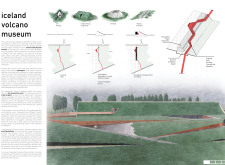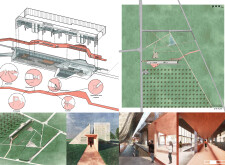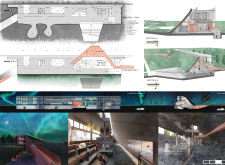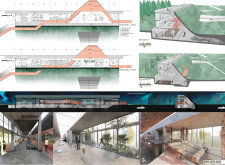5 key facts about this project
The Iceland Volcano Museum is located in a geologically active area in Iceland, where volcanic landscapes are a defining feature. The museum serves as a center for education about the region’s natural history and geological processes. The design concept emphasizes harmony with the surrounding environment while creating engaging experiences for visitors to learn about Iceland's unique volcanic character.
Architecture Concept
The design utilizes a contrast between structured elements and organic forms, dividing the site into different but connected areas. This approach reflects the dual nature of the Icelandic landscape, which features both solid ground and dynamic volcanic activity. The layout encourages movement and exploration, allowing visitors to engage with the exhibit spaces in a thoughtful manner.
Spatial Organization
Positioned beneath an inclined topography, the exhibition area enhances the visitor experience through immersion in the landscape. This choice invites individuals to connect with the various natural features usually associated with volcanic environments. The arrangement prioritizes both visual and tactile experiences, reinforcing the educational focus on the region’s geological traits.
Materiality and Heritage
While the presentation does not specify materials, the design respects local building traditions. It takes cues from historical Icelandic structures, particularly turf houses that demonstrate a long-standing relationship with the natural surroundings. This reference highlights a commitment to sustainability and cultural relevance, aiming to integrate seamlessly with the existing landscape.
Community Engagement
The existing pathway is a critical feature, allowing public access to the museum and encouraging daily interactions with the space. This design choice acknowledges local memory and invites community involvement, enhancing the museum's status as a cultural resource. By blurring the lines between public and private space, the design creates opportunities for informal engagement with the museum's offerings.
The design includes office spaces enclosed in a semi-transparent structure, combining rigid and flexible elements. This setup allows for various functions while fostering social interaction among staff. The open layout ensures visual connections to the exhibition, embodying a design philosophy centered on relationship and engagement in all aspects of the museum experience.






















































